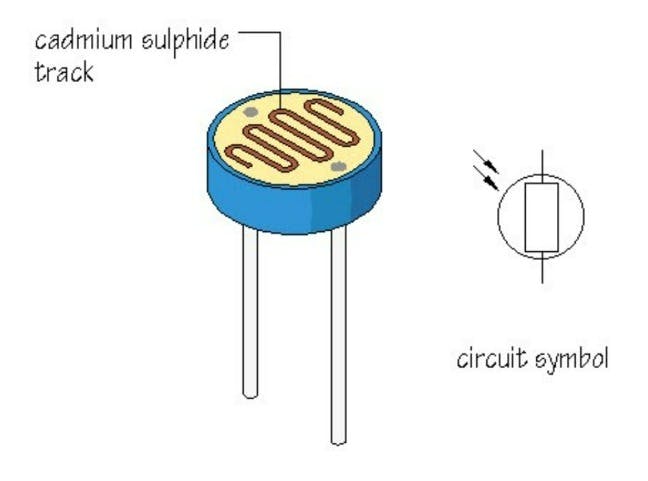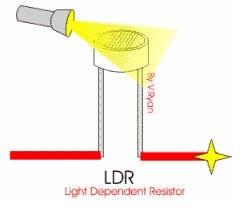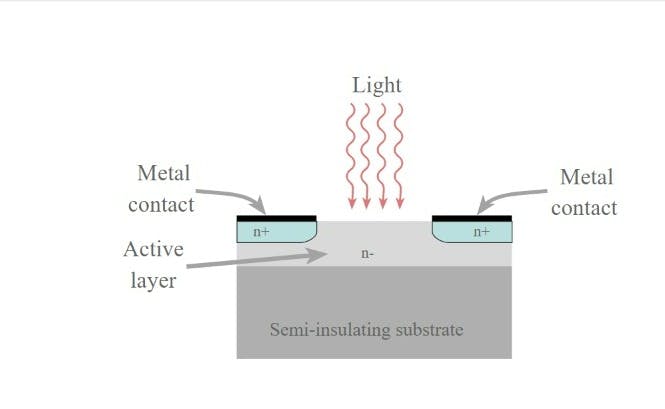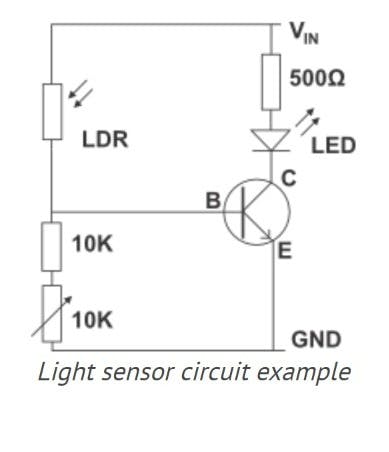WHAT IS AN LDR
An LDR, or light-dependent resistor, is a photoresistor, photocell, or photoconductor. It is a type of resistor whose resistance varies depending on the amount of light falling on its surface. When light falls on the resistor, the resistance changes.
These resistors are often used in many circuits where it is required to sense the presence of light. These resistors have a variety of functions and resistance.

Variation in resistance with changing light intensity
In the dark, their resistance is very high, sometimes up to 1 MΩ, but when the LDR sensor is exposed to light, the resistance drops dramatically, even down to a few ohms, depending on the light intensity. LDRs have a sensitivity that varies with the wavelength of the light applied and are nonlinear devices.
If you place this variation on a graph, you will get something similar to what is shown in the diagram below.

WORKING PRINCIPLE OF LDR
This resistor works on the principle of photoconductivity. It is nothing but, when the light falls on its surface, the material conductivity reduces, and the electrons in the valence band of the device are excited to the conduction band.

These photons in the incident light must have energy more significant than the band gap of the semiconductor material. This makes the electrons jump from the valence band to conduction. If a constant “V’ is applied to the LDR, the intensity of the light increases, and the current increases.
LDR FREQUENCY DEPENDENCY
The sensitivity of photoresistors is shown to vary with the wavelength of the light that is impacting the sensitive area of the device. The effect is very marked, and it is found that if the wavelength is outside a given range, then there is no noticeable effect.
Devices made from different materials respond differently to light of different wavelengths, which means that the other electronic components can be used for various applications.
It is also found that extrinsic photoresistors are more sensitive to longer wavelength light and can be used for infrared. However, when working with infrared, care must be taken to avoid heat build-up caused but the elating effect of the radiation.
STRUCTURE OF LDR
The basic format for a photoresistor is shown below:

The active semiconductor region is typically deposited onto a semi-insulating substrate, and the active region usually is lightly doped.
In many discrete photoresistor devices, an interdigital pattern is used to increase the area of the photoresistor exposed to light. The design is cut in the metallization on the active site's surface, letting the light through. The two metalized areas act as the two contacts for the resistor. This area has to be made relatively large because the resistance of the contact to the active site needs to be minimized.

Because of the environmental concerns of using Cadmium, this material is not used for any European product, and global use of this type of semiconductor has reduced significantly.
TYPES OF LDR
Light-dependent resistors, LDRs, or photoresistors fall into one of two types of categories:
1. Intrinsic photoresistors: Intrinsic photo resistors use un-doped semiconductor materials, including silicon or germanium. Photons that fall on the LDR excite electrons moving them from the valence band to the conduction band.
As a result, these electrons are free to conduct electricity. The more light that falls on the device, the more electrons are liberated and the greater the conductivity level, which results in a lower level of resistance.
2. Extrinsic photoresistors: Extrinsic photoresistors are manufactured from semiconductors of materials doped with impurities. These impurities or dopants create a new energy band above the existing valence band.
As a result, electrons need less energy to transfer to the conduction band because of the smaller energy gap.
Regardless of the type of light-dependent resistor or photoresistor, both types exhibit an increase in conductivity or fall in resistance with increasing levels of incident light.
CHARACTERISTICS OF LDR
(1) Photocurrent and bright resistance: Under a specific applied voltage, when there is light, the current flowing through the LDR is called the photocurrent, and the ratio of the applied voltage to the LDR is called the bright resistance, which is usually indicated by “100LX”.
(2) Dark current, dark resistance: Under a specific applied voltage, the current flowing through the LDR is called a dark current when there is no light. The ratio of the applied voltage to the dark current is called the dark resistance, which is usually indicated by “0LX”.
(3) Activeness: Reactivity refers to the relative change value of the LDR's resistance value (dark resistance) when it is not illuminated by light and the resistance value (bright resistance) when it is inspired by light.
(4) Spectral care: Spectral care is also called spectral activity, which refers to the activity of LDR under monochromatic light of different wavelengths. If the degree of activity at different wavelengths is drawn as a curve, the curve of spectral care can be obtained.
(5) Light characteristics: The illumination characteristic refers to the part where the LDR's electrical signal output changes with the illuminance. It can be seen from the light characteristic curve of the LDR that the resistance of the LDR starts to decrease flexibly with the increase of the light intensity. If the light intensity is further increased, the resistance value change will decrease, gradually becoming ever. Under most conditions, this characteristic is nonlinear.
(6) Volt-ampere characteristic curve: The volt-ampere characteristic curve is used to describe the connection between the applied voltage of the LDR and the photocurrent. For the photosensitive device, the LDR increases with the increase of the applied voltage.
(7) Temperature coefficient: The photoelectric effect of LDRs is greatly affected by temperature. Some LDRs have higher photoelectric activity at low temperatures but lower activity at high temperatures.
(8) Rated power: Rated power refers to the LDR's ability to consume in a specific circuit. When the temperature increases, the energy consumed decreases.
TYPICAL APPLICATIONS OF LDR
Photoresistors are most often used as light sensors. They are usually utilized when it is required to detect the presence and absence of light or measure the light intensity. Examples are night lights and photography light meters. An interesting hobbyist application for light-dependent resistors is the line following robot, which uses a light source and two or more LDRs to determine the needed change of course. Sometimes, they are used in other sensing applications, for example, in audio compressors, because their reaction to light is not instantaneous. So the function of the LDR is to introduce a delayed response.

AUDIO COMPRESSORS
Audio compressors are devices that reduce the audio amplifier's gain when the signal's amplitude is above a set value. This is done to amplify soft sounds while preventing the loud sounds from clipping. Some compressors use an LDR and a small lamp (LED or electroluminescent panel) connected to the signal source to create changes in signal gain. Some believe this technique adds smoother characteristics to the signal because the response times of the light and the resistor soften the attack and release. The delay in the response time in these applications is of the order of 0.1 s.
LIGHTING SWITCH FROM SUNSET TO SUNRISE
This sunset to sunrise lighting switch controls the light illuminated on the LDR sensor. The resistance of the LDR sensor changes with the change in intensity of light falling on LDR. This sensor output is given to IC 555 timer connected in bistable mode. The o/p of the IC 555 timer is used to control the prompting of load through a TRIAC. Hence, this circuit switches on the bag at sunset and automatically switches off the pack at sunrise.

